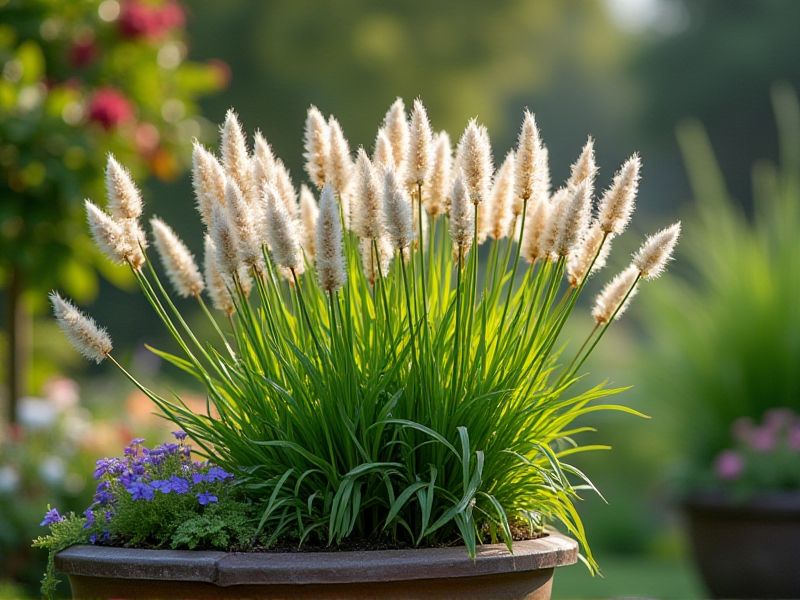
Container plants that tolerate wind are essential for gardeners in exposed locations. Hardy varieties such as ornamental grasses, sedums, and certain evergreens like boxwood create a robust visual appeal while withstanding harsh gusts. For vibrant colors, consider wind-resistant flowering plants like lavender and salvia, which not only endure breezy conditions but also attract pollinators. When selecting container sizes, opt for larger, heavier pots to ensure stability against strong winds. Incorporating a mix of these resilient plants can enhance your outdoor space while minimizing damage from wind exposure.
List of some Container plants that tolerate wind
- Spider Plant (Chlorophytum comosum)
- Snake Plant (Sansevieria trifasciata)
- Lavender (Lavandula angustifolia)
- Rosemary (Salvia rosmarinus)
- Oleander (Nerium oleander)
- Geranium (Pelargonium spp.)
- Boxwood (Buxus sempervirens)
- Olive Tree (Olea europaea)
- Agapanthus (Agapanthus africanus)
- Yucca (Yucca spp.)
Important things about Container plants that tolerate wind
Choosing Hardy Plant Varieties
When selecting container plants that can withstand windy conditions, consider hardy varieties such as ornamental grasses, succulents, and certain flowering perennials. Plants like blue fescue and purple fountain grass offer not only resilience but also add visual interest to your outdoor spaces. Choose compact forms of plants like the dwarf boxwood or trailing vinca that maintain their structure even under gusty conditions. Ensuring the right weight of the container and proper drainage is essential for sustaining these resilient plants in high-wind environments.
Importance Of Pot Weight And Stability
Pot weight is crucial for container plants that need to withstand wind, as a heavier pot reduces the risk of tipping over during strong gusts. Stability is enhanced by selecting wider, lower-profile pots, which distribute weight more evenly and lower the center of gravity. Additionally, using materials such as ceramic or heavy-duty plastic can further improve the resistance against wind forces. Knowing which plants, like ornamental grasses or hardy shrubs, are particularly wind-tolerant can help you design a resilient garden in breezy areas.
Utilizing Windbreaks For Protection
Container plants that tolerate wind include hardy varieties such as ornamental grasses, succulents, and certain flowering perennials. These plants not only withstand strong breezes but also enhance the aesthetic of your outdoor space. Implementing windbreaks, like fences or strategically placed shrubs, can further shield your container plants from harsh weather conditions, promoting healthier growth. Choosing wind-resistant species ensures that your garden remains vibrant and thriving while minimizing maintenance challenges.
Selecting Deep-Rooted Plants
When choosing container plants that tolerate wind, select deep-rooted species to enhance stability and resilience. Varieties such as ornamental grasses, like Miscanthus sinensis, and robust flowering plants, such as Rudbeckia, are excellent choices for windy locations. These plants develop strong root systems that anchor them securely, minimizing the risk of uprooting during gusty conditions. To further protect your container garden, consider placing heavier pots or using materials that provide additional weight and stability.
Regular Watering To Maintain Soil Moisture
Container plants that tolerate wind require consistent watering to maintain optimal soil moisture, especially to buffer against the drying effects of strong gusts. Utilizing well-draining potting soil ensures that excess water can escape, preventing root rot while still retaining necessary moisture. You should monitor soil moisture levels regularly, as the wind can rapidly evaporate water, leaving plants stressed. Selecting wind-resistant varieties, such as ornamental grasses or hardy succulents, can enhance your container garden's resilience against harsh conditions.
Using Larger Containers For Better Stability
Selecting larger containers for your wind-tolerant plants can significantly enhance their stability and resilience against harsh weather conditions. Containers with a wider base provide a lower center of gravity, reducing the risk of tipping during strong gusts. Heavy materials like ceramic or concrete can further anchor your plants, improving their ability to withstand wind. By choosing sturdy, larger pots with good drainage, your container plants will not only survive but thrive, showcasing vibrant blooms and lush foliage even in breezy environments.
Choosing Drought-Resistant Species
When selecting container plants that tolerate wind and are drought-resistant, consider options such as the Lavender (Lavandula) and the Euphorbia. These species not only thrive in dry conditions, but their resilient structures enable them to withstand gusty weather, making them ideal for exposed locations. Incorporating these plants into your garden will not only enhance its visual appeal but also promote sustainability by reducing water usage. To maximize their growth, ensure proper drainage in your containers and choose a well-aerated potting mix that retains minimal moisture.
Seasonal Adjustments For Wind Exposure
Selecting container plants that tolerate wind is essential for maintaining a vibrant garden in exposed areas. Species like ornamental grasses, such as Miscanthus or Panicum, offer not only resilience against harsh winds but also dynamic movement and texture. Consider incorporating hardy succulents, like Agave or Sedum, that thrive in breezy conditions and require minimal maintenance. To enhance stability, ensure your containers are weighted appropriately, and use a well-draining potting mix to support healthy root development even during windy seasons.
Pruning For Wind Resistance
Pruning container plants appropriately enhances their wind resistance, allowing them to thrive in breezy environments. You should focus on removing any dead or heavy branches, which can catch wind and destabilize the plant. Choosing wind-tolerant species like ornamental grasses or hardy succulents can provide added resilience, as these plants naturally adapt to windy conditions. Regular maintenance, including pruning and ensuring proper pot weight, will help your container plants withstand strong gusts and flourish over time.
Monitoring Plant Health Regularly
Container plants that tolerate wind are essential for gardeners in exposed locations, as they can remain resilient even in harsh weather conditions. Varieties such as ornamental grasses, succulents, and certain perennials thrive in elevated locations, effectively withstanding strong gusts while providing visual interest. When selecting container plants, consider using heavier pots for stability and ensuring proper drainage, which helps prevent root rot during wet weather. Regular monitoring of your plants' health will keep them thriving, enabling you to enjoy a vibrant and sustainable container garden.
